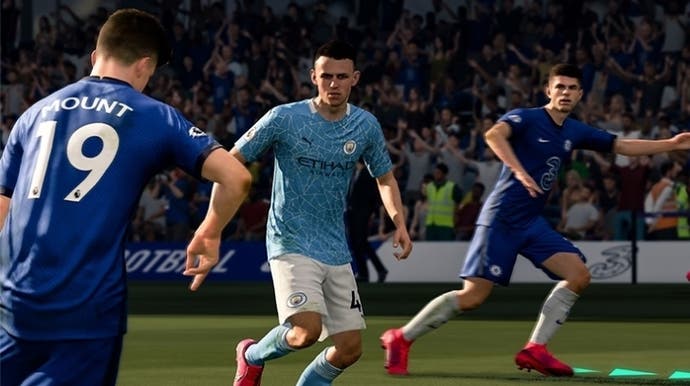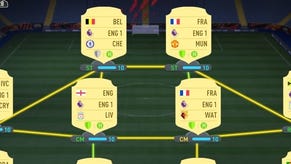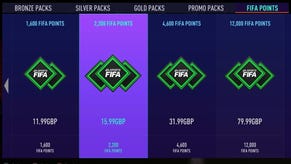FIFA 21 plays a better game of football that will keep fans on-side for now
Constant press.
FIFA 21 has a lot of welcome changes when it comes to the actual gameplay, but after playing the game for a weekend, it's hard to call this year's entry a game changer.
Perhaps this shouldn't come as much of a surprise. FIFA 21 launches as the next generation of consoles arrives, and traditionally our industry's great transition has always been low-key for FIFA. As the developers at EA Sports manage launching their great cash cow on new platforms for the first time, big-ticket new features are hard to come by. Instead we have hardcore-pleasing tweaks and a handful of cool new on-the-pitch features. You tend to get the truly eyebrow raising stuff once FIFA is bedded in to new consoles, not as it takes its first steps onto their virtual pitches.
So, what we have with FIFA 21 is a game that certainly plays better than its predecessor, but there's no real wow factor. FIFA 21 plays like a game with all the right changes in all the right places, but it will do nothing to convince those who accuse the series of selling little more than roster updates dressed in full-price clothes each year.
My first impression was that FIFA 21 felt a tad faster than FIFA 20. It felt more responsive, which will have contributed to the feeling of faster gameplay. Players certainly feel more reactive to your input. This is welcome, given responsiveness is one of the biggest issues with FIFA. But I should note I was playing offline on a PlayStation 4. There was no way to play by preview build online, where responsiveness is at its most troublesome.
After a few matches I started to notice some nice little flourishes. The through ball is much better in FIFA 21. The ball arcs into space in a nice-looking way, often into the path of the target. It feels like the game targets the right space more often, whereas I often feel FIFA 20 sends my through balls in the wrong direction.
Players jump over other players now. This sounds like a rather inconsequential change, but it's actually a pretty big deal for FIFA. FIFA 20 and its predecessors would often descend into a nightmarish mess of wayward physics as competing under-the-hood systems sent players crashing into each other in increasingly disturbing ways. FIFA 21 does the simple thing of making an attacker hurdle an on-rushing goalkeeper, which not only makes for a nice, realistic-looking sequence, but prevents FIFA from going full on Cthulhu.
FIFA 21 has a new dribbling mechanic designed to recreate how the best players wiggle out of pressure from defenders. It's called Agile Dribbling, a proper noun because EA Sports likes to give its new systems, however trivial, titles. To do it you need to press the right bumper and move the left stick in the direction you want your player to go to. All players in the game can do this, but attributes are taken into account. Good dribblers, such as France wonderkid Kylian Mbappe and Barcelona legend Lionel Messi have faster feet than the likes of Manchester United lump Phil Jones. But then who doesn't?
It's actually quite useful, in a match. It's not some get out of jail free move, but it is an effective counter for the jockey mechanic. Interestingly, it sometimes happens automatically. This contextual version of agile dribbling is optional, but enabled by default. It makes your players automatically perform Agile Dribbling in certain situations, for example in a one v one.
But the best new gameplay mechanic by far is the Creative Runs (no, this isn't a nod to Gary Lineker's unfortunate World Cup moment). There are three available: Directed Pass and Go (flick the right stick right after you pass in any direction and the passing player will start running there); Directed Runs (trigger a run with the left bumper or call for support with the right bumper, then flick the right stick right away in the direction you want the player to go); and the Player Lock (keep control of the player who makes the pass and let the CPU take control of the ball).
That's a lot to take in, but the upshot is you've got much more control in FIFA 21 over player runs than any previous FIFA game, really. Control is, like responsiveness, a long-standing FIFA issue. There's this feeling that you're never truly in control of what's going on. Rather, you're doing your best to encourage your players to do your bidding. With these new Creative Runs, you have full 360 degree control over the player you're directing.
It's pretty accessible, too. The Directed Pass and Go works with any type of pass. You simply pass then flick the right stick in the direction you want the player to run in. I found myself using this one most often, as the timing on the other two options is a bit more fiddly. The Player Lock in particular is an advanced mechanic, and I imagine it'll go down well with hardcore players who want total control over player runs. You can have up to five players performing a Directed Run or Directed Pass and Go simultaneously, which is way too many for my simple footballing brain to contend with, but those who fuss with FUT Champions and the like will no-doubt have fun with it.
I also noticed attackers were caught offside less often, and defenders made interceptions more often. This is down to new attributes: positioning and defensive awareness. The positioning attribute impacts onside and offside runs, among other things, whereas the defensive awareness attribute affects a defensive midfielder's ability to cut out passing lanes - aka the N'Golo Kanté special. You really do feel this is actually working during a match, particularly with players with high numbers in these categories, which is pretty cool.
Some other positive changes I felt: headers are back, after EA Sports pretty much eradicated their effectiveness for FIFA 20. I scored more headed goals during my weekend with FIFA 21 than I have done all year with FIFA 20. It turns out EA Sports has made manual heading mandatory in all FUT modes, including FUT Champions, FUT Rivals and FUT Squad Battles, as well as all Pro Clubs modes, FIFA Seasons, FIFA Co-Op Seasons and FIFA Online Friendlies. Basically, you've got manual heading to contend with in any meaningful competitive multiplayer. This is to improve the viability of scoring with headers while keeping a skill gap in the game, EA Sports said. Whatever the tuning, old reliable Olivier Giroud was a menace with his head at FIFA 21 near-post corners for me. In FIFA 20 they'd never go in.
Also of note: I liked the new nutmeg skill move, which worked more than I thought it would. EA has ditched a couple of toxic celebrations and alongside that picked up the speed of the game when it comes to skipping cinematics and getting the ball back into play. More on that here. The new Cancel Foul Advantage mechanic is pretty cool, too. Here, you can press both triggers to ask for the foul instead of keeping the advantage of the play (good for free kick fans). You can call players into the box on goal kicks (right bumper), which lets you build up play as teams like to do in real life these days. And the super cancel is much better. You can even super cancel some skill moves. Bit fighting game, that.
And finally, a word on the new team press timer. When FIFA 20 launched, the drop back quick tactic was deemed overpowered, so EA added the team press quick tactic to counter it. But the team press then became overpowered. So, for FIFA 21, team press is no longer a constant pressure defensive tactic. It now triggers a temporary auto press on demand, but with a cooldown timer that prevents it from being overused. Smart.
Despite all these quality of life improvements, you'd be forgiven for thinking FIFA 21 was FIFA 20 just by looking at it. I didn't notice any significant graphical upgrades. Some of the player faces look super realistic, but superstar players have looked fantastic in FIFA for some time now. The stadiums I played in looked a bit flat. And, crucially, I think FIFA 21's ball feels just about the same as it has done in recent years. PES has FIFA's number here. Konami's game has the better virtual football - it just feels better to kick around, to pass over the top, to shoot on the half volley. FIFA 21 still has that FIFA thing of feeling like the ball is made up of ones and zeroes - it doesn't have any heart, no magic.
Gameplay is just one part of FIFA 21, of course. The most important part, perhaps, but only one. There's Volta, the FIFA Street-style mode introduced last year and set to return this year in slightly improved form. There's Career Mode, which already looks and sounds better than FIFA 20's catastrophic effort. And of course the brilliant, problematic, fascinating and deeply troubling Ultimate Team. All of these parts of FIFA 21 will be discussed in detail by EA Sports at a later date. But there's no signature new main mode to play; no rewrite of the FIFA rulebook. FIFA 21 offers sensible, welcome improvements that will keep the core on-side for another year, but not much else.
Roll on next-gen.












